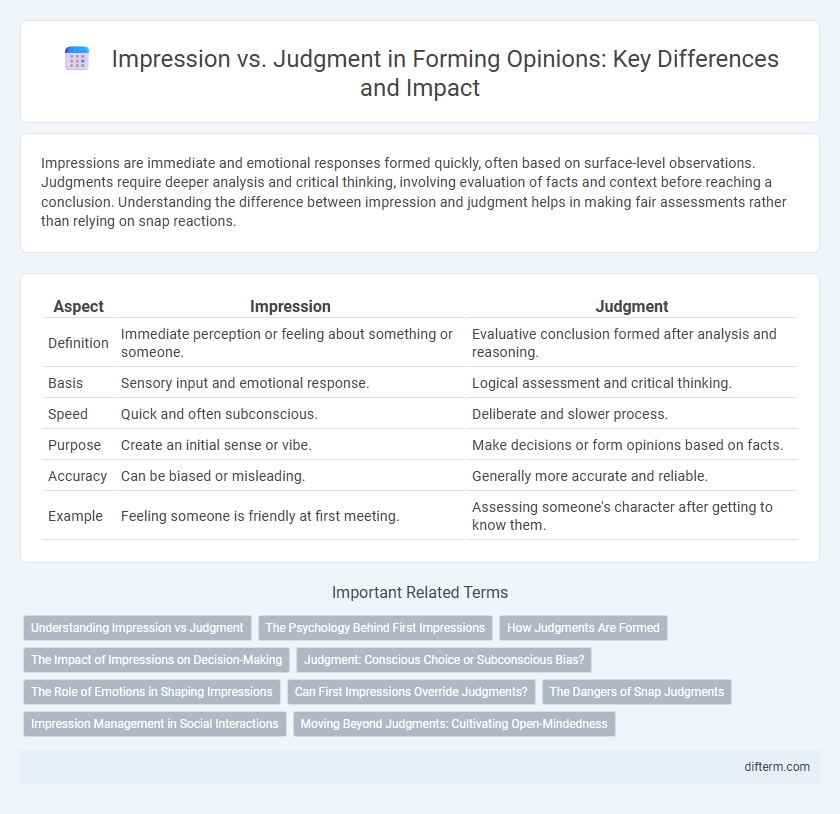Impressions are immediate and emotional responses formed quickly, often based on surface-level observations. Judgments require deeper analysis and critical thinking, involving evaluation of facts and context before reaching a conclusion. Understanding the difference between impression and judgment helps in making fair assessments rather than relying on snap reactions.
Table of Comparison
| Aspect | Impression | Judgment |
|---|---|---|
| Definition | Immediate perception or feeling about something or someone. | Evaluative conclusion formed after analysis and reasoning. |
| Basis | Sensory input and emotional response. | Logical assessment and critical thinking. |
| Speed | Quick and often subconscious. | Deliberate and slower process. |
| Purpose | Create an initial sense or vibe. | Make decisions or form opinions based on facts. |
| Accuracy | Can be biased or misleading. | Generally more accurate and reliable. |
| Example | Feeling someone is friendly at first meeting. | Assessing someone's character after getting to know them. |
Understanding Impression vs Judgment
Impression forms through immediate sensory experiences and emotional responses, shaping an intuitive perception without deep analysis. Judgment involves deliberate evaluation and critical thinking, integrating reasoned assessment to reach a conclusion. Understanding this distinction enhances clarity in decision-making processes by balancing intuition with rational scrutiny.
The Psychology Behind First Impressions
First impressions are formed within milliseconds based on facial expressions, body language, and tone of voice, heavily influenced by the brain's amygdala, which processes emotional responses. These rapid assessments often rely on cognitive shortcuts known as heuristics, leading to potential biases that affect subsequent judgment accuracy. Understanding the psychological mechanisms behind first impressions highlights the challenge of separating instinctive perception from deliberate evaluation in social interactions.
How Judgments Are Formed
Judgments are formed through a complex cognitive process involving evaluation of evidence, personal experiences, and contextual factors that go beyond initial impressions. Unlike impressions, which are immediate and often superficial, judgments require deliberate analysis and critical thinking to assess the accuracy and relevance of information. Neuroscientific studies reveal that the prefrontal cortex plays a significant role in integrating emotional and rational inputs to produce well-founded judgments.
The Impact of Impressions on Decision-Making
Impressions significantly influence decision-making by shaping initial perceptions that often guide subsequent judgments, frequently without full consideration of facts. Cognitive biases such as the halo effect demonstrate how favorable first impressions can distort objective evaluation, leading to quicker but potentially less accurate decisions. Understanding the weight of these subconscious impressions is crucial for improving critical thinking and making more informed, rational choices.
Judgment: Conscious Choice or Subconscious Bias?
Judgment involves a complex interplay between conscious choice and subconscious bias, often shaped by prior experiences and cognitive shortcuts. While conscious judgment allows deliberate evaluation based on evidence and reasoning, subconscious biases can skew decisions without awareness, leading to partial or flawed conclusions. Understanding the balance between these factors is crucial for developing more accurate and fair assessments in personal and professional contexts.
The Role of Emotions in Shaping Impressions
Emotions play a crucial role in shaping first impressions by influencing how sensory information is processed and evaluated within milliseconds of an encounter. These affective responses often operate unconsciously, leading to quick assessments that can overshadow objective judgment and allow biases to form. Understanding the impact of emotions on impression formation reveals why initial perceptions are powerful yet sometimes unreliable predictors of character.
Can First Impressions Override Judgments?
First impressions often establish a powerful cognitive anchor that can bias subsequent judgments, making it challenging to override initial perceptions. Research in social psychology reveals that people tend to rely on these immediate assessments, which shape their expectations and interpretations of future behavior. However, deliberate reflection and exposure to contradictory evidence can gradually modify or even reverse these early impressions.
The Dangers of Snap Judgments
Snap judgments often lead to distorted perceptions by relying on incomplete information, which can result in unfair or inaccurate assessments of people or situations. The danger lies in the brain's tendency to prioritize immediate impressions over thoughtful analysis, reinforcing biases and perpetuating misunderstandings. Avoiding impulsive conclusions requires conscious effort to gather more context and critically evaluate before forming opinions.
Impression Management in Social Interactions
Impression management plays a crucial role in social interactions by allowing individuals to control how others perceive them, often influencing initial impressions more than objective judgments. Techniques such as self-presentation, nonverbal cues, and selective disclosure are strategically employed to shape favorable opinions and social outcomes. Understanding impression management reveals the complex interplay between appearance and reality in forming social judgments.
Moving Beyond Judgments: Cultivating Open-Mindedness
Moving beyond judgments requires cultivating open-mindedness by recognizing the limitations of initial impressions and embracing diverse perspectives. Open-mindedness fosters intellectual humility, allowing individuals to question biases and consider alternative viewpoints. This approach enhances empathy, critical thinking, and constructive dialogue, promoting deeper understanding in social and professional interactions.
impression vs judgment Infographic

 difterm.com
difterm.com